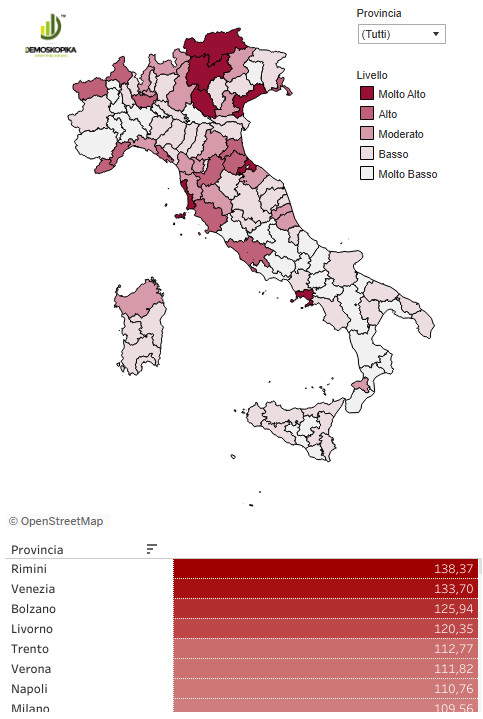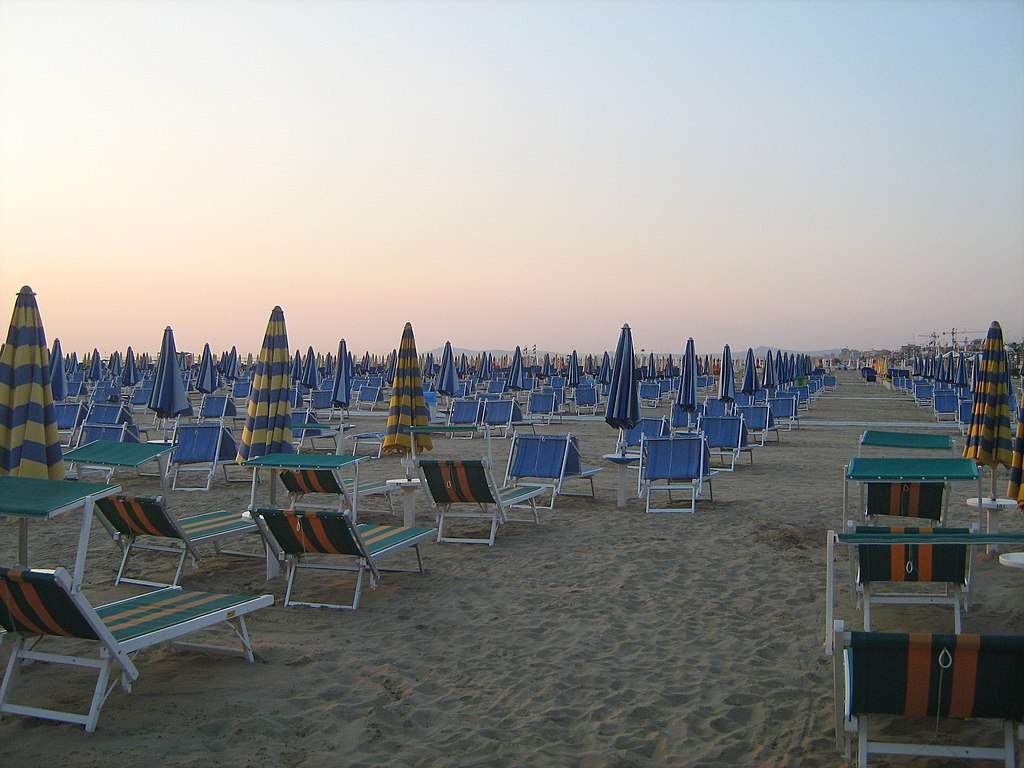64 tourists per resident in Bolzano, 14 thousand tourists per square kilometer in Venice, 71.65 kilograms of waste per tourist in Rimini. Sonno some of the numbers that emerge from the survey by the Demoskopika research institute, published exclusively by Ansa.it, which has elaborated various factors to determine an Overall Index of Tourist Overcrowding (ICST), designed, on an experimental basis in order to assess overall tourist overcrowding in Italian provinces. It is developed through a combination of indicators reflecting different dimensions of tourism impact: the indicators identified by the researchers are tourism density, accommodation density, tourism intensity, gross utilization and share of urban waste attributable to the tourism sector.
In the resulting ranking we see that leading the way in the combined five indicators is Rimini, followed by Venice, Bolzano, Livorno, Trento, Verona and Naples. These provinces are ranked with a “Very High” overcrowding range. “Overcrowding in these areas is beginning to be more than concerning with critical impacts on local quality of life and sustainability of tourist destinations. Also more than relevant, given the size of the cities, is the ranking of tourist destinations such as Rome and Florence, which are in the ”High“ level of the Index. In these destinations in particular, according to the Institute’s researchers, there is significant pressure on local resources, with obvious problems in managing tourist flows.”
The provinces with “High” Level are: Milan, Savona, Ravenna, Rome, Trieste, Imperia, La Spezia (with the 5 Terre), Grosseto, Florence, Gorizia, Aosta, Forlì-Cesena. With “moderate” Level are: Siena, Monza and Brianza, Brescia, Padua, Genoa, Sassari (with La Maddalena), Vibo Valentia (with Tropea), Lucca, Pistoia, Como, Bologna, Pisa, Pesaro and Urbino.
The municipality of Rimini, with its 6.7 million presences in 2023, ranks sixth in the ranking of the most visited Italian municipalities (where the first place is Rome, followed by Venice, Milan, Florence and Cavallino-Treporti, a municipality on the Venetian coast that is the European capital of campsites, which last year surpassed the municipality of Rimini with 6.8 million presences).
Demoskopica’s analysis has the merit of probing the level of tourist presence in aspects but is weak in its choice of territorial parameter since many provinces have the capital and the rest of the province following often opposite or contrasting dynamics (just think of those on the sea versus those in thehinterland of the same province) or, in other contexts that live on tourism by season, spreading the impact suffered in only 4 months over 12 months gives a partial reading of the effect received by residents. The debate in which this research is inserted seems to look at the numbers only for their negative side, but it is not necessarily the case that for a Rimini resident having a hotel saturation level of nearly 100 percent in the summer months and close to zero in the rest of the year is considered negative or unbearable. The application of such a research methodology to municipal rather than provincial territories only is thedesirable improvement it would have in helping public administrators and utility managers analyze their own territories.
The index, in the intent of the statistical institute, aims to encourage greater evolution of the phenomenon on local tourism systems by helping to understand how tourism affects population density, the use of accommodation infrastructure, the intensity of tourism interaction relative to residents and, finally, the environmental impact related to waste management.


“Overtourism,” says Raffaele Rio, president of Demoskopika, “not only threatens the sustainability of our most beloved destinations but also risks compromising the quality of experience for visitors and the quality of life for residents. Tourist overcrowding is a wake-up call that calls us to action, promoting more responsible and sustainable tourism. It is essential to implement tourism management policies that include time and number restrictions on access to the most at-risk places, along with strategies to promote alternative destinations that are less well-known but just as rich in culture and beauty as well as encouraging off-season tourism by promoting places even during less crowded periods.”
Let’s look in detail at the individual rankings divided by research factor. “Tourist Density” is measured by the concentration of tourists per unit area, providing direct insight into physical overcrowding in specific areas. A high value can indicate potential tourist congestion and increased pressure on local resources and the environment. In this case we have Rimini in the lead with 16,751 tourists per square kilometer. It is followed by Venice with 14,325 per square kilometer, Naples with 9,780, Milan 8,454 tourists per square kilometer, Livorno 7,791, Trieste 6,664, Rome with 5,966, Verona with 5,531, Bolzano, 4,645, Gorizia 3,809, Monza and Brianza 3,452, Ravenna 3,429, Savona 3,347, La Spezia 3,205, and Florence with 3,104 per square kilometer if we consider the entire metropolitan city area. But we are well aware that in the square mile of the historic center, density reaches far greater heights than this figure.
“Receptive Density” (Beds/Territorial Extent) reflects the number of beds available per unit area, highlighting how tourism infrastructure can influence the density and overcrowding of an area. Areas with high accommodation density may experience overloading of local infrastructure during tourism peaks. In Rimini there are 194.2 beds per sq. km; Venice 158.4 beds per sq. km; Livorno 104.4 per sq. km; Naples 89.3; Trieste 72.2; in Milan 71.9 and in Rome 60.3.
With “Tourist Intensity” (Tourist Presences/Resident Population) we have a ratio of tourist presences to resident population that provides a measure of the relative impact of tourism on residents’ daily lives. High values may indicate a strong impact of tourism on the local community, with possible social and infrastructural strains. In this ranking we see Bolzano with 64 tourists per resident, Rimini with 42.6 tourists per resident, Venice with 42.4 tourists per resident, Trento 32.6, Livorno 29.0, Aosta 27.0, Grosseto 26.6; Siena 19.5. In Firenz 11 tourists per resident, 18.47 in Verona, 7.6 in Rome.
The fourth factor is theGross Utilization Index, i.e. (Tourist Presences / (Beds * 365)) * 100, a formula that shows the percentage of actual utilization of available beds, offering a measure of the intensity with which accommodation facilities are used. High utilization may signal excessive pressure on facilities, contributing to overcrowding.
The fifth parameter is the “Share of Urban Waste per Tourist,” whose formula is : (Waste Production / Resident Population) - (Waste Production / (Tourist Presences + Resident Population / 365). This indicator, defined by Ispra, captures the contribution of the tourism sector to municipal waste production, highlighting how much waste produced per capita is affected by the tourist movement. The indicator is obtained from the difference between the per capita production of municipal waste calculated with the
resident population and the per capita production of urban waste calculated, on the other hand, with the “equivalent population,” which is obtained by adding to the resident population the tourist presences recorded during the year and spread over the 365 days. Rimini has 71.6 kg of waste, Bolzano 71.2; Venice 60.1; Livorno 50.4; Grosseto 43.6; Aosta 42.5; and Florence 16.3.
Demoskopica points out that the official sources used for the data matrix were Istat for the retrieval of arrivals and presences on a provincial basis referring to 2022, resident population on a provincial basis referring to 2022, capacity of accommodation establishments (number of establishments and number of beds) on a provincial basis referring to 2022, total area in square kilometers on a provincial basis (adjusted to current provincial boundaries, and ISPRA for municipal waste production on a provincial basis referring to 2022.
 |
| Tourism, Rimini is the most overcrowded city, followed by Venice |
Warning: the translation into English of the original Italian article was created using automatic tools. We undertake to review all articles, but we do not guarantee the total absence of inaccuracies in the translation due to the program. You can find the original by clicking on the ITA button. If you find any mistake,please contact us.